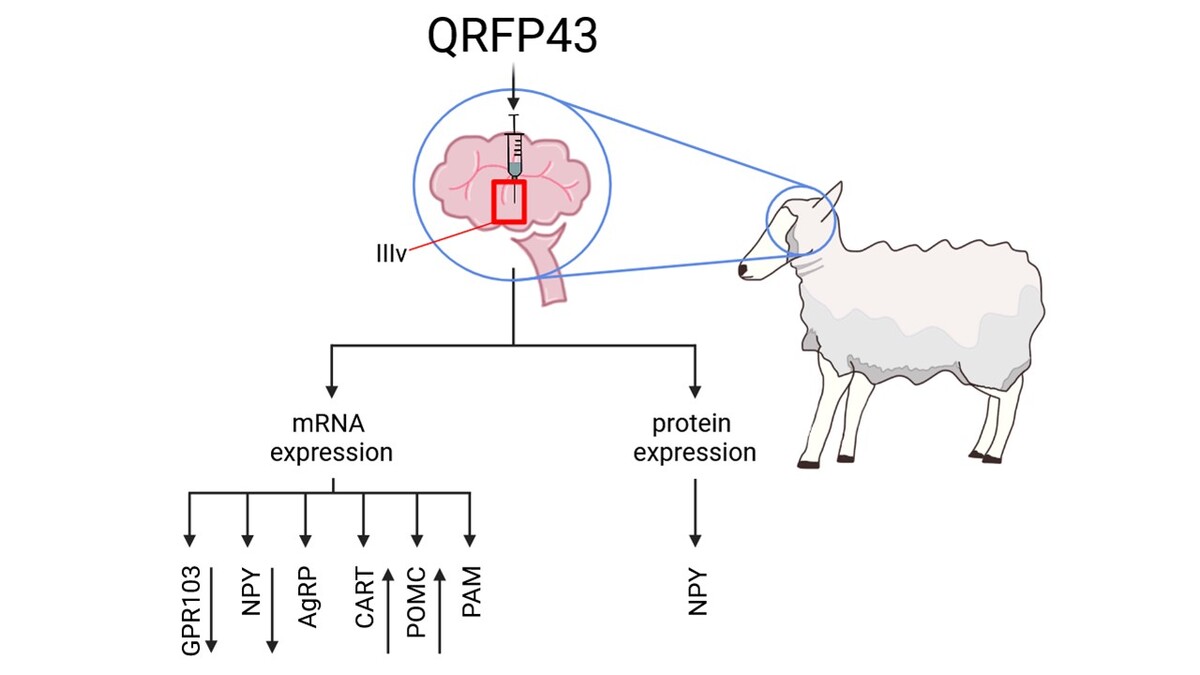SHORT COMMUNICATION
QRFP43 modulates the activity of the hypothalamic appetite regulatory centre in sheep
1
The Kielanowski Institute of Animal Physiology and Nutrition, Polish Academy of Sciences, Department of Animal Physiology,
Instytucka 3, 05-110 Jabłonna, Poland
Publication date: 2024-04-22
Corresponding author
B. J. Przybył
The Kielanowski Institute of Animal Physiology and Nutrition, Polish Academy of Sciences, Department of Animal Physiology, Instytucka 3, 05-110 Jabłonna, Poland
The Kielanowski Institute of Animal Physiology and Nutrition, Polish Academy of Sciences, Department of Animal Physiology, Instytucka 3, 05-110 Jabłonna, Poland
KEYWORDS
TOPICS
ABSTRACT
The neuromodulatory effect of pyroglutamylated RFamide peptide
43 (QRFP43) on the hypothalamic appetite regulation centre in sheep has not
yet been investigated. The present work focuses on the role of QRFP43 in
modulating mRNA expression of pyroglutamylated RFamide peptide receptor
(QRFPR), neuropeptide Y (NPY), agouti related neuropeptide (AGRP), cocaine- and amphetamine-regulated transcript prepropeptide (CARTPT), proopiomelanocortin (POMC), peptidyglycine
alpha-amidating monooxygenase (PAM) and NPY protein expression in the
hypothalamic arcuate nucleus in sheep. The aim of this study was to investigate
whether QRFP43 could affect gene expression of the appetite-regulating
centre in the hypothalamus. The experiment was conducted from September
to December and included forty-eight female Polish Merino sheep randomly
assigned to three groups. The control group received an intracerebrovenctricular
infusion of Ringer-Locke solution (480 μl/day), whereas the experimental
groups were administered QRFP43 in two doses: 10 or 50 μg/480 μl/day
(referred to as the RFa10 and RFa50 groups). Selected brain structures were
collected from animals for immunohistochemical and real-time PCR analyses.
Central infusions of QRFP43 induced changes in mRNA expression of the NPY,
CARTPT, POMC and QRFPR genes. A decrease in NPY and QRFPR mRNA
expression, and an increase in CARTPT mRNA expression were detected.
Furthermore, infusion of QRFP43 in the RFa50 group resulted in decreased
POMC mRNA expression. Our findings suggest that QRFP43 may exert an
inhibitory effect on the hypothalamic neuronal network responsible for appetite
regulation in sheep. Moreover, it appears that the effect of QRFP43 may vary
in different animal species, thus further research is required, especially involving
hormonal proteomic analyses.
ACKNOWLEDGEMENTS
The authors would like to express their gratitude
to veterinary surgeons K. Roszkowicz-Ostrowska
and D. Szkopek, for their assistance in brain surgery.
Appreciation is also extended to A. Misztal
and K. Biernacka for their help with experiments
and immunohistochemical and radioimmunological
analyses. Special thanks are given to W. Mrozek and
R. Druchniak for their excellent care of the animals
during the study.
FUNDING
This research was supported by funds provided
by the National Science Centre, Poland,
PRELUDIUM 17 grant No. 2019/33/N/NZ9/00287.
CONFLICT OF INTEREST
The Authors declare that there is no conflict of
interest.
REFERENCES (14)
1.
Chartrel N., Dujardin C., Anouar Y. et al., 2003. Identification of 26RFa, a hypothalamic neuropeptide of the RFamide peptide family with orexigenic activity. Proc. Natl. Acad. Sci. USA 100, 15247–15252, https://doi.org/10.1073/pnas.2....
2.
Chartrel N., Alonzeau J., Alexandre D., Jeandel L., Alvear-Perez R., Leprince J., Boutin J., Vaudry H., Anouar Y., Llorens-Cortes C., 2011. The RFamide neuropeptide 26RFa and its role in the control of neuroendocrine functions. Front. Neuroendocrinol. 32, 387–397, https://doi.org/10.1016/j.yfrn....
3.
do Rego J.C., Leprince J., Chartrel N., Vaudry H., Costentin J., 2006. Behavioral effects of 26RFamide and related peptides. Peptides 27, 2715–2721, https://doi.org/10.1016/j.pept....
4.
Kampe J., Wiedmer P., Pfluger P.T. et al., 2006. Effect of central administration of QRFP(26) peptide on energy balance and characterization of a second QRFP receptor in rat. Brain Res. 1119, 133–149, https://doi.org/10.1016/j.brai....
5.
Lectez B., Jeandel L., El-Yamani F.-Z. et al., 2009. The orexigenic activity of the hypothalamic neuropeptide 26RFa is mediated by the neuropeptide Y and proopiomelanocortin neurons of the arcuate nucleus. Endocrinology 150, 2342–2350, https://doi.org/10.1210/en.200....
6.
Leprince J., Bagnol D., Bureau R. et al., 2017. The Arg-Phe-amide peptide 26RFa/glutamine RF-amide peptide and its receptor: IUPHAR Review 24. Br. J. Pharmacol. 174, 3573–3607, https://doi.org/10.1111/bph.13....
7.
Moriya R., Sano H., Umeda T., Ito M., Takahashi Y., Matsuda M., Ishihara A., Kanatani A., Iwaasa H., 2006. RFamide peptide QRFP43 causes obesity with hyperphagia and reduced thermogenesis in mice. Endocrinology 147, 2916-2922, https://doi.org/10.1210/en.200....
8.
Primeaux S.D., 2011. QRFP in female rats: Effects on high fat food intake and hypothalamic gene expression across the estrous cycle. Peptides 32, 1270–1275, https://doi.org/10.1016/j.pept....
9.
Primeaux S.D., Barnes M.J., Braymer H.D., 2013. Hypothalamic QRFP: regulation of food intake and fat selection. Horm. Metab. Res. 45, 967–974, https://doi.org/10.1055/s-0033....
10.
Przybył B.J., Szlis M., Wójcik-Gładysz A., 2020. Brain-derived neurotrophic factor affects mRNA and miRNA expression of the appetite regulating centre in the sheep arcuate nucleus. Ann. Anim. Sci. 20, 853–869, https://doi.org/10.2478/aoas-2....
11.
Przybył B.J., Szlis M., Wójcik-Gładysz A., 2021. Brain-derived neurotrophic factor (BDNF) affects the activity of the gonadotrophic axis in sheep. Horm. Behav. 131, 104980, https://doi.org/10.1016/j.yhbe....
12.
Szlis M., Polkowska J., Skrzeczyńska E., Przybył B.J., Wójcik-Gładysz A., 2018. Does obestatin modulate the hypothalamic appetite-regulating network in peripubertal sheep? J. Anim. Physiol. Anim. Nutr. 102, 690–700, https://doi.org/10.1111/jpn.12....
13.
Takayasu S., Sakurai T., Iwasaki S. et al., 2006. A neuropeptide ligand of the G protein-coupled receptor GPR103 regulates feeding, behavioral arousal, and blood pressure in mice. Proc. Natl. Acad. Sci. USA 103, 7438–7443, https://doi.org/10.1073/pnas.0....
14.
Wójcik-Gładysz A., Szlis M., 2016. Hypothalamo-gastrointestinal axis - role in food intake regulation. J. Anim. Feed Sci. 25, 97–108, https://doi.org/10.22358/jafs/....
We process personal data collected when visiting the website. The function of obtaining information about users and their behavior is carried out by voluntarily entered information in forms and saving cookies in end devices. Data, including cookies, are used to provide services, improve the user experience and to analyze the traffic in accordance with the Privacy policy. Data are also collected and processed by Google Analytics tool (more).
You can change cookies settings in your browser. Restricted use of cookies in the browser configuration may affect some functionalities of the website.
You can change cookies settings in your browser. Restricted use of cookies in the browser configuration may affect some functionalities of the website.




